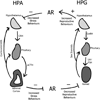Androgen receptors, sex behavior, and aggression
- PMID: 22414851
- PMCID: PMC3474193
- DOI: 10.1159/000337663
Androgen receptors, sex behavior, and aggression
Abstract
Androgens are intricately involved in reproductive and aggressive behaviors, but the role of the androgen receptor in mediating these behaviors is less defined. Further, activity of the hypothalamic-pituitary-gonadal axis and hypothalamic-pituitary-adrenal axis can influence each other at the level of the androgen receptor. Knowledge of the mechanisms for androgens' effects on behaviors through the androgen receptor will guide future studies in elucidating male reproductive and aggressive behavior repertoires.
Copyright © 2012 S. Karger AG, Basel.
Figures

References
-
- McGinnis MY, Marcelli M, Lamb DJ. Consequences of mutations in androgen receptor genes, molecular biology and behavior. In: Pfaff DW, editor. Hormones, Brain and Behavior. New York: Academic Press; 2002. pp. 347–380.
-
- Tenbaum S, Baniahmad A. Nuclear receptors, Structure, function and involvement in disease. The International Journal of Biochemistry &, Cell Biology. 1997;29(12):1325–1341. - PubMed
-
- Mangelsdorf DJ, Evans RM. The RXR heterodimers and orphan receptors. Cell. 1995;83(6):841–850. - PubMed
-
- Heemers HV, Tindall DJ. Androgen receptor (AR) coregulators, a diversity of functions converging on and regulating the AR transcriptional complex. Endocr Rev. 2007;28(7):778–808. - PubMed

